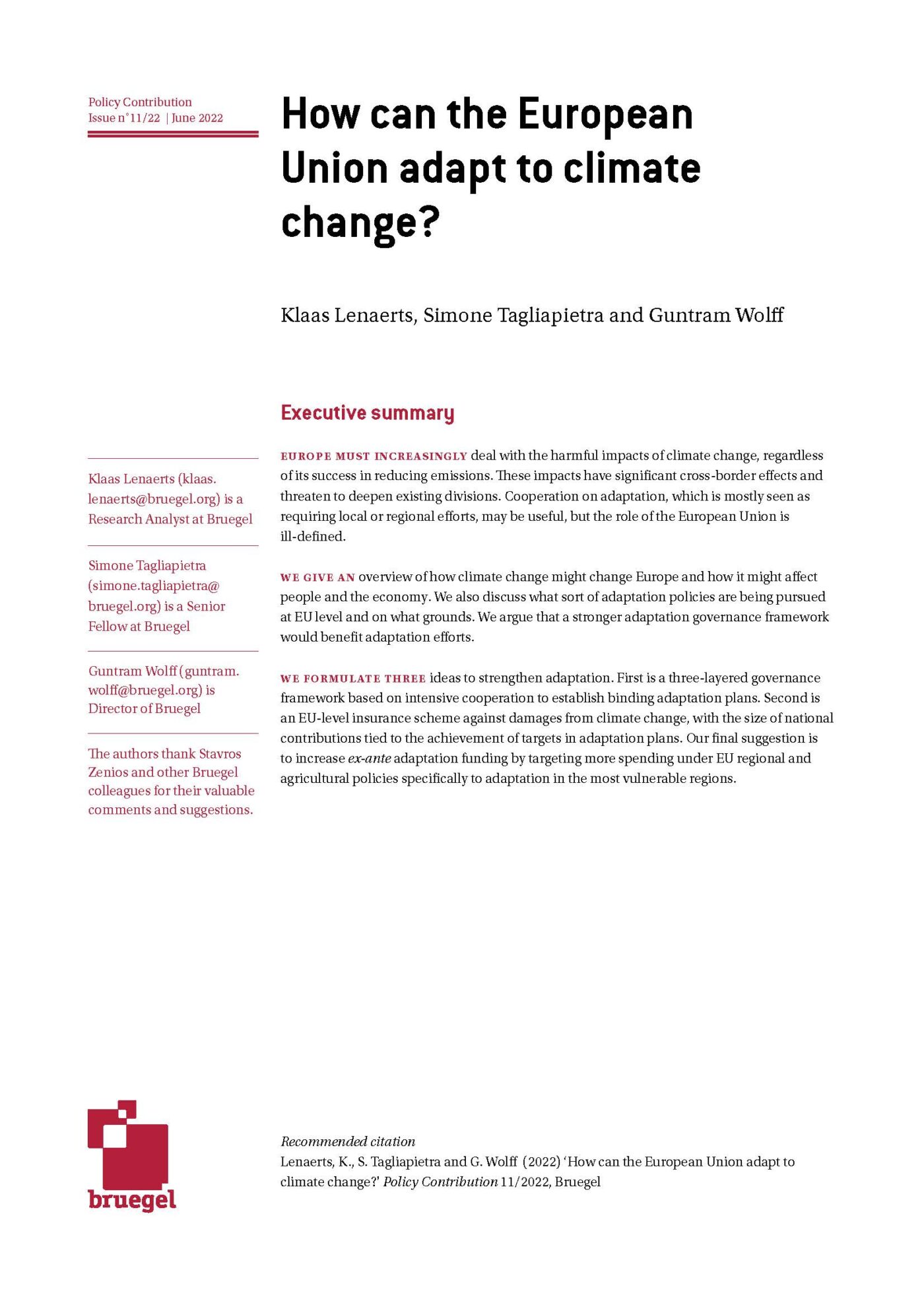Blog Post
US separates climate concerns from financial oversight in contrast to EU activism
Different EU and US supervisory approaches to climate risk may hamper efforts to work together and risk fragmenting global markets.
Climate change is a growing financial risk as well as an environmental threat. Increasingly, banks and asset managers are seeking ways to prevent future climate shocks from upending their businesses, while investors often seek ways to push their financial resources in ways that will help, rather than hurt, efforts to address global warming. Sustainable finance has grown rapidly over the past year, accelerated by the response to the COVID-19 pandemic, even if it still makes up only a fraction of global financial markets.
Central banks have joined the debate, but different supervisory approaches by the United States and the European Union may hamper efforts to work together. European central bankers increasingly see their mandate as actively pushing market prices to reflect environmental trends in banking supervision, corporate disclosures and possibly also monetary policy. In contrast, American supervisors prefer to monitor risk while leaving climate strategy to lawmakers and scientists. President Biden has embraced climate issues, in contrast to the Trump administration which sought to prohibit pension funds from including climate concerns in their investment decisions. But Biden’s financial policymakers have not budged from their view that central banks should not be directing asset allocation or offering direct climate intervention. This may fragment global markets rather than encourage collaboration on the green transition.
European Central Bank President Christine Lagarde acknowledged in January that central bankers will have to look beyond their traditional duties to address the challenge. The bank’s bond-buying programmes currently hold about a fifth of the green bonds that are eligible, and the ECB is increasing the proportion of climate-conscious investments it holds in its pension and other operational funds. Lagarde identified three “interlocking dimensions” of necessary policy change: incorporating the true cost of carbon into assessments of the broader economy; assessing the exposure of individual companies; and facilitating green innovation and investment. “Each of them lies outside the remit of central banks, but will have important implications for central bank balance sheets and policy objectives,” Lagarde said. This broad and forward-looking approach to climate risk stands out in comparison to the ECB’s primary mandate of ensuring price stability.
In Europe, policymakers have put environmental trends at the forefront of the agenda. The ECB has created a climate change centre to coordinate work taking place throughout its ranks. Central bankers from throughout the euro area have weighed in on how the ECB can adapt its bond-buying practices to accelerate the green transition. The question seems to be how, not whether.
ECB Executive Board Member Isabel Schnabel said in September 2020 that central banks should be an active part of the collective effort to reduce carbon emissions. Schnabel noted that green bonds tend to trade at higher yields than their conventional counterparts, due to lower liquidity and the market not prioritising climate change costs to society. She said central banks could help the market self-correct by requiring climate disclosures for ECB-eligible collateral, reassessing the benchmark allocation of asset-purchase programmes, or possibly even excluding securities deemed out of step with climate goals. Monetary policy should not lock in investments in sectors that are out of step with the climate transition, she argued. This met with pushback from Bundesbank President Jens Weidmann, who in November said the central bank should prioritise disclosures but not asset allocation. Nonetheless, in January he argued that inadequate climate disclosures could be a dealbreaker for the Eurosystem: “In my view, we should consider only purchasing bonds or accepting them as collateral for monetary policy purposes if their issuers meet certain climate-related reporting requirements.”
Momentum has continued to build in the euro area. Executive Board Member Fabio Panetta said ECB analysis can help make climate-risk valuations more accurate. Bank of France Governor François Villeroy de Galhau said in February the overall scale of central bank easing is sufficient to spur the green transition, particularly if the ECB shifts its portfolio to advance its policy goals. Speaking at Bruegel (11 February), Dutch central bank chief Klaas Knot concurred that central bank purchases can play a more active role, and called for governments to be more assertive in raising the cost of greenhouse gas emissions and making sure this pricing extends throughout the economy. Knot said supervisors need to incorporate climate risk into all of their safety and soundness oversight, noting that Dutch financial firms alone have more than €500 billion in ecosystem exposures.
In the US, where the Federal Reserve has a dual mandate to promote maximum employment as well as stable prices, policymakers have been more careful to keep central bank efforts within traditional lines. Fed Chairman Jerome Powell said in December that the Fed will not be taking climate considerations into account as part of its quantitative easing programmes. “We have historically shied away strongly from taking a role in credit allocation,” Powell said, noting that the Fed does not have a mandate from Congress to play a more active role in climate matters.
This is not to say the Fed is ducking the issue. On the contrary, the US Central Bank in December formally joined the Network of Central Banks and Supervisors for Greening the Financial System (NGFS), a standard-setting body in which it had been participating as an observer for more than a year. The Fed also, for the first time, included climate risks in its financial stability report, citing both acute and long-term hazards. Climate-related disruptions are likely to increase financial system vulnerability. Real estate faces particular risks, the report said, and rapid public shifts in risk perception also can lead to “abrupt repricing” and other shocks.
Scholars such as Bruegel’s Alexander Lehmann have argued that the relevance of climate to financial regulation is no longer in doubt. Where the ECB plans to tackle these risks head on, however, the US is pursuing a more informational approach. European bank regulators are planning a stress testing exercise in 2022 that looks specifically at climate risks to banks. The ECB’s banking supervision arm has requested that banks conduct a climate risk self-assessment and draw up action plans, which it will begin assessing this year. And the ECB is carrying out a climate risk stress test exercise to assess the impact on the European banking sector over a 30-year horizon.
But both the Fed and the US Treasury, led by former central banker Janet Yellen, oppose including climate risks in bank stress testing. Powell said the Fed’s focus needs to be squarely on financial supervision and financial stability, and “it’s less obvious to me that those should be first-order things that we would look at in connection with climate change.” In confirmation testimony to the Senate, Yellen went further. “I am concerned about recent proposals to advance a liberal environmental policy agenda through the regulation of banks and other financial institutions. Particularly troubling are calls to implement climate stress tests on banks. Financial regulators lack the expertise to make environmental policy,” she said in written responses to questions.
Yellen’s strong views may come as a surprise to some who thought she had become more open to the idea of climate stress tests since stepping down as Fed chair in 2018. A report from the Group of 30 (G30) explicitly called for such testing to become part of the central banking toolkit: “Financial institutions’ own scenario analysis is an important step toward measuring and managing the specific climate-related risks that they face, but it is not sufficient. Central banks and supervisors will need to extend and adapt existing stress testing frameworks to capture the full extent of climate risks,” the report said. It argued these measures were necessary worldwide to ensure comparability of test results and so that authorities could assess system-wide feedback loops.
Yellen co-chaired the steering committee of the G30’s working group on climate issues, alongside former Bank of England Governor Mark Carney and former Swiss Central Bank Chairman Philipp Hildebrand. As a result of her work on this report, she was cited in US media as supporting such stress tests. Her comments to the Senate make clear this is not her personal view, and they indicate her climate-related work at Treasury will focus on initiatives like tax policy, infrastructure spending and promoting green investment – not bank oversight.
Yellen took the position that a lot of climate risk modelling at banks is, in fact, modelling the risk of regulatory intervention rather than financial risk per se. Bank resilience during the coronavirus crisis shows the financial sector has positioned itself to weather a severe unexpected downturn, in contrast to the meltdowns of the global financial crisis. “Rather than regulating the safety and soundness of a financial institution, climate stress tests and other climate policies in the banking space are designed to prevent those institutions from holding certain assets as a form of indirect punishment against disfavoured industries such as oil and gas,” she said. “Thus, climate change regulation is a self-fulfilling prophecy for the government: your oil and gas assets are unprofitable because we have decided to make them so.”
Outside the regulatory sphere, proponents of green finance acknowledge there is a long precedent of considering climate and sustainability criteria as ‘nonfinancial’. The private sector has tried to bridge some of the gap on its own through the Task Force on Climate Finance Disclosures (TCFD), an industry-led initiative backed by the Financial Stability Board. However, there is concern that differing approaches from Europe and the US will cause compliance headaches and provide conflicting incentives because of the default ways in which climate is considered relevant to financial projections. In the US, firms may need to show that climate risks are material before incorporating them into financial plans. In Europe, the momentum is the reverse: banks and others with a fiduciary duty may need to show climate change is not material if they wish to exclude it from forecasts.
The US can bridge some of this gap by offering companies and financial firms a standard set of ways to conduct their own assessments, the industry argues. A recent discussion hosted by S&P Global made the case that the Biden administration could make a big difference by offering precise scenarios and precise timeframes to provide more consistency to the market. Companies may not be trying to withhold information, but they can’t provide data they are not collecting. Investors need more due diligence and disclosure to figure out which risks are material and why.
The US is still in the early stages of assessing how financial regulation interacts with climate responsibility. Fed officials have pointed out that stress tests focus on a fairly short time horizon, rather than the longer-term outlook of climate concerns. Banks did not include climate risks in the challenges they identified to the Fed as most significant over the next 12-28 months. There is recognition that the economic consequences of climate change, and the accompanying economic transition to greener technologies, will have direct implications for banks and could lead to increased risk. Financial stability could eventually come into play, Fed Governor Lael Brainard said in a December 2020 speech. Supervisors say they expect banks to have systems in place that identify, measure, control and monitor all of their material risks, including climate risk where applicable. For now, however, the US may take a wait-and-see approach rather than joining Europe in pushing banks to change.
Recommended citation:
Christie, R. (2021) ‘US separates climate concerns from financial oversight in contrast to EU activism’, Bruegel Blog, 18 February
Republishing and referencing
Bruegel considers itself a public good and takes no institutional standpoint. Anyone is free to republish and/or quote this post without prior consent. Please provide a full reference, clearly stating Bruegel and the relevant author as the source, and include a prominent hyperlink to the original post.












